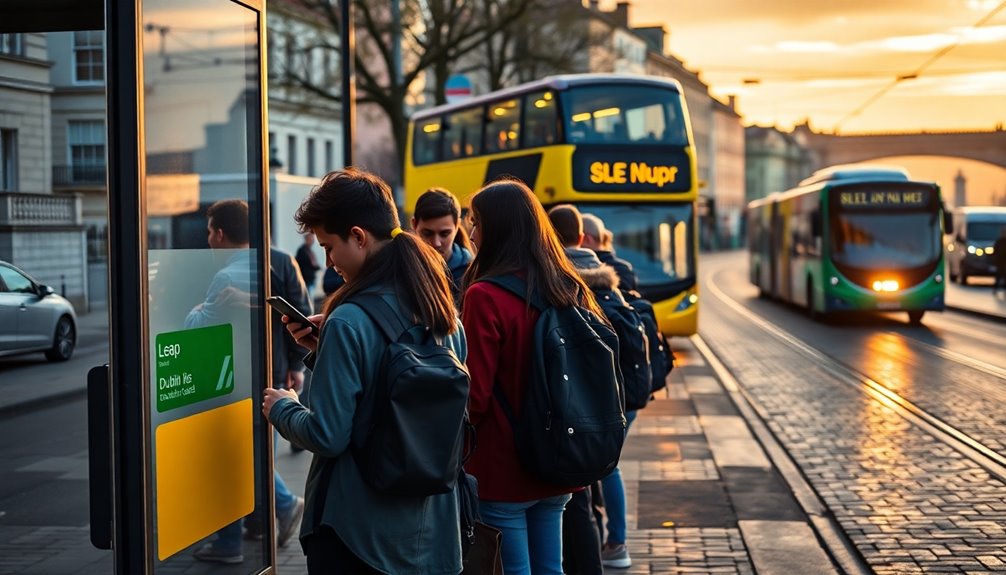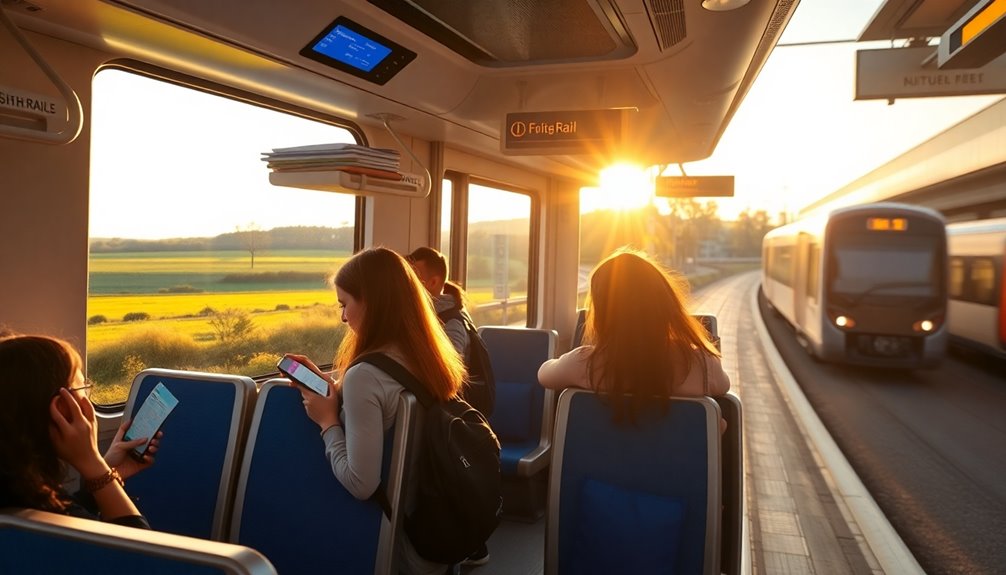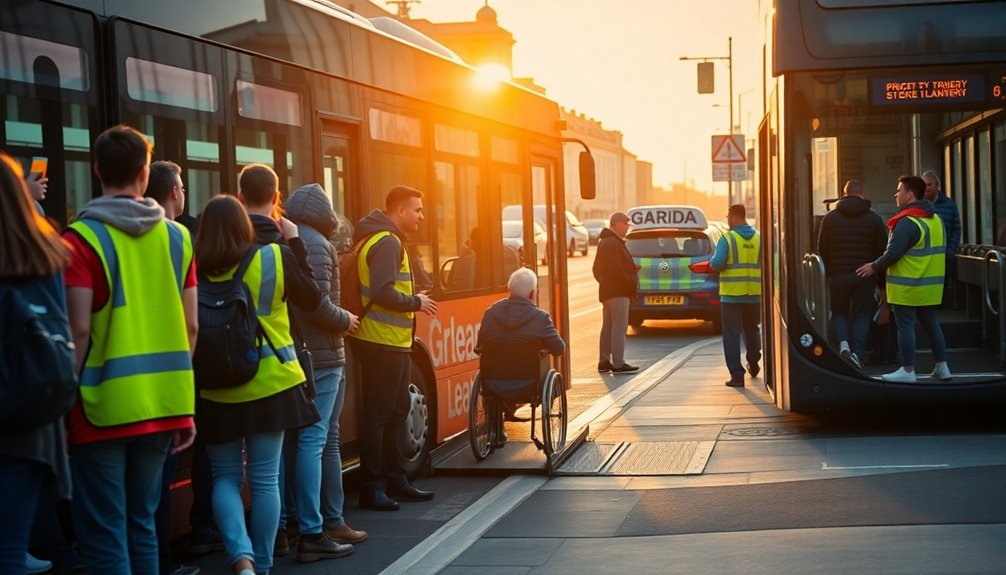
You’ll plan trips by mapping origin, destination and transfers, then compare routes to cut wait times and fares. Get a Student Leap Card for discounted travel and follow Irish Rail, bus and tram timetables for reliable connections. Learn peak vs off‑peak, ticket validation and bike carriage rules, plus safety and accessibility etiquette. Prepare backup routes for delays, strikes and airport transfers. Keep these basics in mind — the full guide shows practical step‑by‑step tips and examples.
Highlights
- Get a Student Leap Card for discounted fares and top up online or at service points before you travel.
- Plan trips using official timetables and real-time apps to minimize transfers and avoid delays.
- Choose trains for speed, buses for local links, and trams for short urban journeys; compare total travel time and cost.
- Combine modes (bike-share, park-and-ride, walking) to solve first/last-mile gaps and reduce wait times.
- Observe safety, accessibility, and etiquette: queue, offer priority seats, secure bags, and follow operator alerts.
Planning Your Journey: Routes, Maps and Timetables
When planning a trip on Ireland’s public transport, start by identifying your origin, destination and any transfer points so you can compare direct routes, travel times and frequencies; that clarity helps you pick the most efficient option. You’ll use route optimization to minimize transfers and wait time, balancing speed against cost. Rely on official timetables and realtime apps, cross-checking schedules for weekends or holidays. For confident map navigation, study network maps and street-level layouts before you go, noting alternate corridors if delays occur. That preparation gives you freedom to adapt, travel efficiently and avoid unnecessary detours.
Getting the Student Leap Card and Travel Discounts
You’ll start by applying for a Student Leap Card online or at a service point, supplying proof of identity and student status. Once approved, compare student discount rates across buses, trams and regional rail to see which routes offer the biggest savings. Knowing application steps and fare structures lets you quantify potential monthly and annual reductions in travel costs.
Applying for Leap Card
Although the process is straightforward, getting a Leap Card — and specifically a Student Leap Card — requires a few precise steps and documents, so it’s worth knowing what’s needed before you apply. You’ll need proof of identity, student status, and a passport-style photo. Start online to complete the application process, then post required documents or visit an authorised vendor if needed. Consider photo quality, expiry dates, and payment options for initial top-up. The card’s leap card benefits justify the setup: easier travel, automated fares, and flexibility. Keep copies of submissions and track delivery to avoid delays.
Student Discount Rates
Having your Student Leap Card in hand makes saving on fares straightforward, but knowing the exact discount rates, eligibility rules and how they apply across buses, trams and trains will help you get the best value. You’ll find standard reductions—typically 50% on local services and varied rates on intercity routes—subject to student eligibility criteria like full-time enrollment and age limits. The discount application process is simple: verify documents, apply online or at a sales point, then activate the entitlement on your card. Compare options, check transfer rules, and plan routes to maximize savings while keeping your mobility and independence.
Navigating Trains: Irish Rail and Commuter Services

Ireland’s rail network, anchored by Irish Rail (Iarnród Éireann), connects cities, towns and many commuter suburbs with regular intercity and suburban services; understanding schedules, fare types, and ticketing options will help you plan efficient journeys and avoid delays or fines. You’ll evaluate train types—intercity, regional and commuter—and match them to trip distance and speed needs. Check service frequency for peak and off-peak times, noting reduced weekend runs. Use online timetables, realtime apps and advance purchase discounts to save money and time. Validate tickets at platforms where required and keep ID for student concessions to avoid penalties.
Mastering Buses: Local, Intercity and Express Options
When you’re choosing a bus for a short hop or a cross-country trip, it helps to know how local, regional and express services differ in coverage, frequency, ticketing and onboard amenities. You’ll use local routes for short, frequent hops; expect basic seating, exact-fare or Leap card payments, and strict bus etiquette during busy times. Regional buses link towns with moderate frequency and simpler fares. Express or intercity coaches prioritise speed, comfort, reserved seats, and advance bookings — ideal when you want flexibility and range. Compare timetables, book smartly, carry ID, and choose the service that matches your pace and freedom.
Using Trams and Light Rail: Luas and Metro Planning
When planning tram or light rail trips you’ll want to study routes and maps to pick the fastest corridors and best interchange points. Check ticketing rules and Leap integration so fares and transfers are seamless across Luas, MetroLink options and buses. Also factor peak-time frequencies and likely transfer wait times to minimize total journey time.
Routes and Maps
Maps are your clearest tool for traversing tram and light-rail options across Dublin and beyond, showing service corridors, interchange points, and planned extensions so you can plan trips efficiently. Use map navigation to compare Luas lines with bus routes and rail, spotting fastest transfers and potential delays. You’ll examine frequency, stop spacing, and end-of-line connections to choose routes that maximize speed and flexibility. Study proposed Metro corridors to anticipate future shortcuts and altered interchange hubs. Keep digital and paper maps handy, layer live updates when possible, and adapt itineraries to preserve your time and independence.
Ticketing and Leap
1 practical step to simplify tram and light-rail travel is getting familiar with Leap — Ireland’s integrated smart card and fare system — so you’ll save time and money across Luas, DART, Commuter and many bus services. Use Leap for pay-as-you-go or period passes; compare ticket types to match how often you ride. Check fare zones for Luas to estimate costs and plan routes that minimize zone crossings. Top up online or at machines, tap on/tap off consistently, and monitor balances. That way you’ll keep mobility flexible, reduce costs, and focus on where you want to go.
Peak Times/Transfers
Although peak periods can make journeys slower, understanding Dublin’s Luas and planned Metro rhythms lets you plan transfers to cut waiting and walking time. You’ll avoid delays by timing trips outside rush hour when possible, or by using reliable transfer stations where lines meet to shorten connections. Check timetables and real-time apps to sync arrivals, note platform layouts to minimise walking, and consider slight route detours that reduce overall journey time. During busy windows, board early services or travel against flow to secure space. Smart transfer choices increase mobility and keep your schedule flexible without sacrificing speed.
Buying Tickets: Apps, Machines and Paper Options
When you’re planning travel in Ireland, buying tickets is straightforward but varies by mode and operator, so knowing your options saves time and money. You’ll choose between mobile ticketing apps, on-board or station machines, and paper tickets. Apps let you store, display and sometimes top up fares; they’re flexible if you like minimal physical clutter. Machines accept cards and cash for immediate trips, useful when connectivity’s poor. Paper tickets still matter on regional routes or for inspections. Check validation rules, refund policies and where inspectors operate so you can move freely without surprises.
Cost-Saving Strategies: Passes, Off-Peak Travel and Sharing
Now that you know how and where to buy tickets, it pays to think about ways to lower what you actually spend on travel. Evaluate weekly and monthly passes versus pay-as-you-go based on your schedule; passes often cut costs if you commute regularly. Shift trips to off-peak times when fares drop and services are less crowded. Coordinate group travel to split fares and access discounts on some regional services. Join loyalty programs and student schemes for periodic offers, points or discounted extensions. Track spending, compare options, and choose the mix that maximizes mobility while minimizing expense.
Safety, Accessibility and Travel Etiquette

Because public transport in Ireland is a shared space, being aware of safety, accessibility and etiquette will make journeys smoother for you and others. You’ll follow posted safety protocols: board and alight promptly, keep aisles clear, and report hazards. Respect accessibility features like priority seating, wheelchair ramps and audio announcements; they’re essential, not optional. Travel light, secure bags, and avoid loud phone calls so everyone keeps freedom to move and rest. Offer seats to those in need and queue orderly. Knowing rules and being considerate reduces risk, speeds transfers and preserves independent travel for all.
Handling Delays, Strikes and Service Disruptions
Although disruptions are unavoidable, you can reduce stress and keep your journey moving by knowing your options and staying informed. You’ll monitor service updates via apps, operator alerts, and social media, then adapt routes or departure times. For strikes, factor in contingency plans: earlier departures, alternative lines, or walking pockets of a route. Practice delay management by estimating extra time and keeping tickets or passes handy for flexible reboarding. Stay calm, communicate changes to classmates or hosts, and use station staff for verified info. Being proactive preserves your freedom to travel despite interruptions.
Combining Modes: Multi-leg Trips and Bike+Public Transport
When delays or strikes force you to rethink a route, combining modes—like linking trains, buses and cycling—lets you rebuild journeys that stay efficient and reliable. You’ll assess schedules, transfer times and fare options, prioritising seamless connections. Use bike sharing programs to cover first- and last-mile gaps, reducing wait and walking time. Multi modal integration apps show real-time options, helping you choose faster or quieter routes. Pack light, lock your bike securely and check carriage rules for cycles on trains or buses. By planning alternatives and embracing modal flexibility, you keep control, save time and broaden your travel choices.
Practical Tips for Moving Between Cities and Airports
If you’re moving between Irish cities or heading to an airport, choose the option that balances cost, travel time and reliability—train services link major cities quickly, coach operators often offer cheaper direct routes (including to airports), and regional buses or car-sharing fill gaps where rail isn’t available. Plan routes using real-time apps, compare city connections for frequency and total journey time, and book airport transfers in advance to lock lower fares. Factor luggage, transfers, and contingency time. If you value freedom, keep flexible tickets or hop-on passes, scout park-and-ride options, and prioritize consistent schedules over marginal savings.
Some Questions Answered
Can I Take Pets on Public Transport in Ireland?
Yes — you can usually take pets on public transport in Ireland, but pet policies vary by operator. You’ll need to follow transport guidelines: small pets often travel in carriers, assistance animals are exempt, and larger animals may be restricted or need a muzzle/lead. Check specific bus, train or tram rules before you go, since fines or refusals can apply. Plan ahead to keep your journey smooth and free.
How Do I Transport Large Musical Instruments?
You can, oddly, treat your oversized cello like a houseguest: plan ahead, book spaces or luggage areas, and pick off-peak travel. Use hard cases and straps for musical instrument storage, secure padding, and travel insurance. For transport safety tips, check carriage rules (some buses/trains need prior notice), lift with a friend, and avoid blocking aisles. Stay flexible, assert your needs politely, and you’ll move tunes without drama.
Are There Student Luggage Allowances on Buses and Trains?
Yes — you generally can bring student bags on buses and trains, but there are luggage restrictions. You’ve got freedom to carry typical backpacks and small suitcases; most operators allow one or two pieces per passenger if they don’t obstruct aisles. Oversized items or large instruments may need advance notice, extra fees, or to be stored in luggage areas. Always check the specific carrier’s policy to avoid surprises.
Can I Use Public Transport With Prescription Medication Refrigeration Needs?
Yes — you can, though you won’t find buses moonlighting as refrigerators. You’ll need proper medication storage like insulated cool bags or small travel refrigerators, plus ice packs and a thermometer. Check train and bus policy for onboard space and security, and carry a doctor’s note and prescription. Travel tips: plan for delays, use portable power if your cooler needs it, and store meds with clear labeling to keep your freedom intact.
Do Transport Operators Accept Contactless Payments From Foreign Cards?
Yes — many operators accept contactless payment options from foreign cards, but foreign card acceptance varies. You’ll usually tap-and-go on buses, trams and many trains, though some regional services or older machines may not support international NFC. Check the operator’s website for accepted networks (Visa, Mastercard, or mobile wallets) and carry a backup (cash or local card). Monitor fees and notify your bank for seamless travel freedom.
Summing Everything Up
Mastering public transport in Ireland makes travel faster and cheaper—use maps, timetables, and the Student Leap Card to cut costs. Note that over 40% of Dublin commuters use public transport, underlining its importance for students. Plan multi-leg trips, combine bike and rail, and know disruption protocols to stay flexible. Prioritize safety and accessibility, learn ticketing rules, and keep apps updated so your campus, city and airport journeys stay reliable and stress-free.
